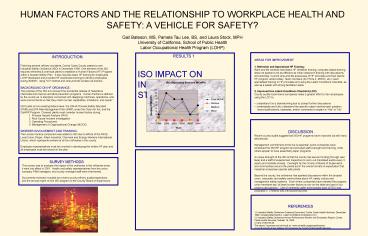RESULTS 1 - PowerPoint PPT Presentation
Title: RESULTS 1
1
HUMAN FACTORS AND THE RELATIONSHIP TO WORKPLACE
HEALTH AND SAFETY A VEHICLE FOR SAFETY? Gail
Bateson, MS, Pamela Tau Lee, BS, and Laura Stock,
MPH University of California, School of Public
Health Labor Occupational Health Program (LOHP)
- RESULTS 1
- ISO IMPACT ON INDUSTRIAL SAFETY STATS
- MCAR Major Chemical Accidents or Releases
- Since Industrial Safety Ordinance Passed 1998
- AREAS FOR IMPROVEMENT
- 1. Refresher and Specialized HF Training
- Rank and file workers need basic HF refresher
training computer-based training does not appear
to be as effective as initial classroom training
with discussions and activities. Current
rank-and-file awareness of HF principles and
their plants HF program varied widely. Team
members (for PHAs,II, MOOC, etc.) need
specialized training in HF principles and using
the Latent Conditions Checklist, as well as a
leader with strong facilitation skills. - 2. Improved Use Latent Conditions Checklist
(LCC) - County audits recommend companies make a greater
effort to train employees using the LCC to - understand it is a brainstorming tool to prompt
further discussions - contemplate and fully understand the specific
reason behind each question - record justifications, examples, and/or
comments to explain a Yes or No - DISCUSSION
- Recent county audits suggest that ISO/HF programs
have improved but still many deficiencies. - Management commitment at the top is essential
some companies have embraced the ISO/HF program
and provided staff oversight and training, while
others appear to have essentially paper programs.
INTRODUCTION Following several refinery
accidents, Contra Costa County passed a new
Industrial Safety Ordinance (ISO) in December
1998. One element of the ISO requires refineries
chemical plants to establish a Human Factors
(HF) Program within a broader Safety Plan. It
also requires basic HF training for employees.
LOHP developed and provided HF awareness training
to refinery employees during 2000/01, using TOT
method and rank-and-file workers as trainers.
BACKGROUND ON HF ORDINANCE The purpose of the
ISO is to prevent the accidental release of
hazardous chemicals and improve accident
prevention programs. Human Factors is defined by
the county as a discipline concerned with
designing machines, operations, and work
environments so that they match human
capabilities, limitations, and needs. ISO
builds on two existing federal laws the OSHA
Process Safety Standard (PSM) and EPA Risk
Management Plan (RMP) under the Clean Air Act,
and the CalARP Program. Covered plants must
consider human factors during 1. Process Hazard
Analysis (PHA) 2. Root Cause Incident
Investigation 3. Operating Procedures 4.
Management of Organizational Change (MOOC)
WORKER INVOLVEMENT AND TRAINING The Human
Factors component was added to ISO due to efforts
of the PACE Local Union (Paper,
Allied-Industrial, Chemical and Energy Workers
International Union), which represents workers at
all four refineries in the county. Employee
representatives must be involved in developing
the written HF plan and all employees must be
trained on the plan.
SURVEY METHODS This survey was to evaluate the
impact of the ordinance in the refineries since
it went into effect in 2001. Health and safety
representatives from the union, company PSM
managers, and county oversight staff were
interviewed. Documents reviewed included two
recent county refinery audits/inspections and the
annual report on the ISO program to the County
Board of Supervisors.































